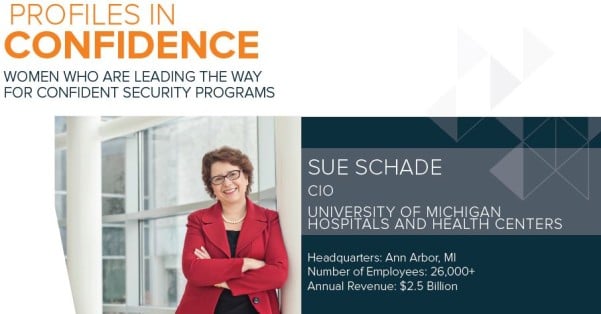
Sue Schade, CIO of The University of Michigan Hospital and Health Centers (UMHHC), is a role model through her many contributions to the industry, and uses her platform to inspire young girls and women. She is a forward-thinking CIO with a heavy focus on elevating and progressing security programs to meet business priorities.
CIO AS A SECURITY ENABLER
“For CIOs who are not security focused, that time has passed,” says Schade. While the CIO at Brigham and Women’s Hospital in the 2000s, Schade viewed a publicly disclosed breach as an opportunity to increase awareness efforts with employees and executives. This breach was an important call to action for leadership to understand the importance of strengthening security.
“Until you get your security program where it needs to be, the CIO will play a greater role in security,” says Schade. When Schade first started as CIO of UMHHC, she spent some of her time on security-related activities, a trend she witnesses among other healthcare CIOs. One of Schade’s priorities is to strengthen the UMHS security program by hiring a health system-level CISO. “To achieve this, I have had to educate upwards with executive leadership and the Board, as well as raise awareness and answer questions and concerns,” explains Schade. Schade’s goal going forward is to provide an objective perspective that contributes to the fluidity and success of the organization.
Schade understands the changes healthcare organizations need to make to maintain an acute awareness that they are a target from a cybersecurity perspective. These changes may eventually include the CISO reporting into the CEO or the auditor/compliance function and an emphasis on not only technical, but also communication skills. “You need a CISO with a level of domain expertise, but you also need someone who can communicate and have the appropriate presence and credibility at the C-suite level. It is a difficult mix, but I look at these skillsets very closely,” Schade comments.
YES YOU CAN: ENCOURAGING GIRLS TO PURSUE CAREERS IN IT
This is one of the titles on Schade’s blog, Health IT Connect. In much of her blog, she provides encouragement and motivation for young girls to follow their interests in IT. She backs up this encouragement with research and her own first-hand experiences. Schade not only writes about empowering young girls, but she takes action by speaking on the topic at college events, conferences, and female-run groups.
Schade believes there are a number of reasons why so few women are in IT. She cites that 18% of Computer Science undergrads are women, a significant drop from 37% in 1984. “There is some analysis that when the PC was introduced in the early 80’s, it was marketed more towards men. This may account for some of the drop-off,” says Schade. Furthermore, she believes there is a certain amount of stereotyping, and a social order in place, which leads to the lack of encouragement for girls to pursue interests in science, technology, engineering, and mathematics (STEM). “We have to support girl-focused STEM programs and expose them to opportunities by opening up their minds to what they could pursue in this particular field,” she comments.
SUPPORTING WOMEN IN THE WORKFORCE
The impact of evolving gender stereotypes and encouraging young girls is evident, yet creating work environments that empower women poses another challenge. “As leaders, we need to create supportive environments for all employees, while encouraging women in particular,” says Schade. She emphasizes an industry-wide effort in conjunction with organizational initiatives, such as female-run groups like HITChicks, Digital Divas, and Women Rising. Recently, Schade took a risk at an 80% male conference by focusing her keynote speech on unlocking the potential in women. “I told my story, shared the data, described the problem, and talked about a call to action. Afterwards, men came up to me to share stories about their daughters’ interests in STEM or programs their companies had for women,” she comments. This receptiveness aligns with the heightened attention the issue is receiving and confirms the need for both men and women leaders to acknowledge the problem, understand solutions, and talk about it.
View the Full Magazine Here